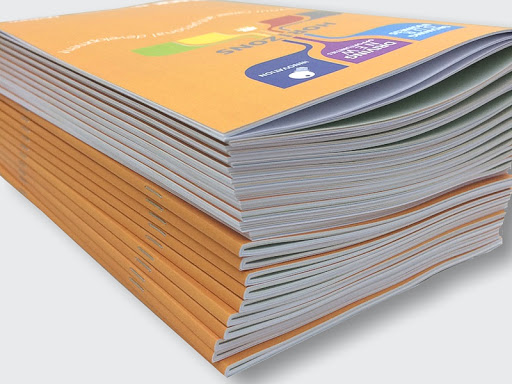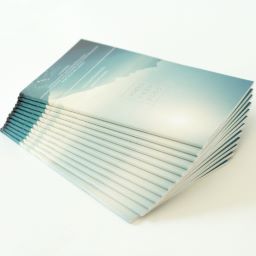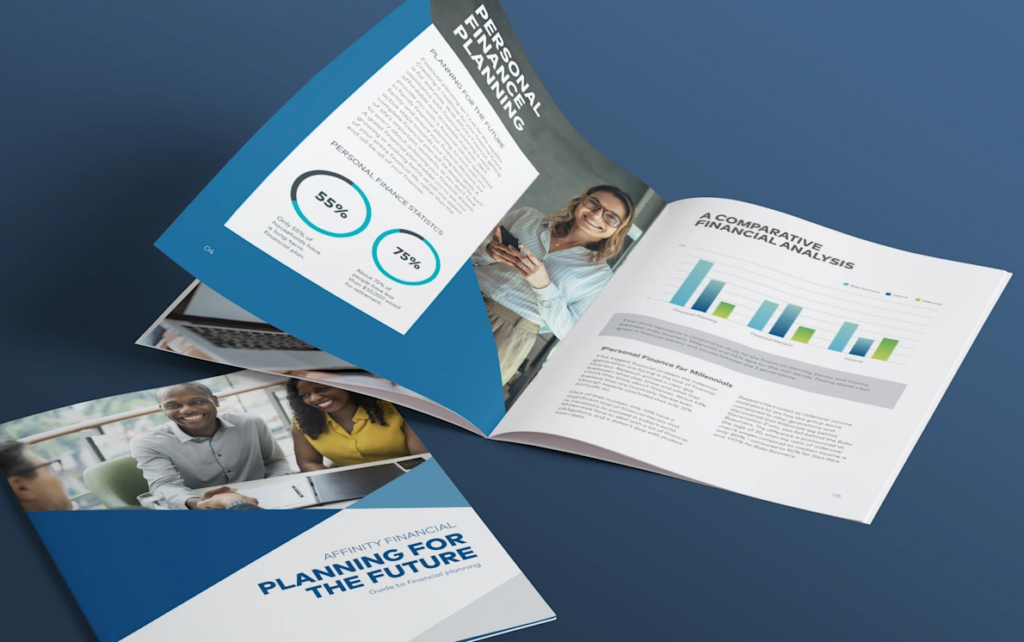The Most Common Mistakes to Avoid in Your Booklet Printing Design
The Most Common Mistakes to Avoid in Your Booklet Printing Design
Blog Article
The Necessary Overview to Comprehending Booklet Printing Options and Techniques
The process of pamphlet printing includes several considerations that can significantly impact the end product. From choosing the ideal style and dimension to understanding the subtleties of binding techniques, each option plays a vital role. In addition, variables such as paper stock and printing strategies additional influence the performance of the brochure. As one browses these alternatives, it ends up being crucial to understand how they adjoin and what that means for the total outcome.
Recognizing Brochure Formats and Sizes
When thinking about booklet printing, recognizing the different formats and dimensions readily available is important for achieving the desired presentation. Pamphlets can be created in countless layouts, including saddle-stitched, spiral-bound, and perfect-bound, each offering distinctive advantages. Usual sizes range from common letter (8.5 x 11 inches) to smaller sized choices like A5 (5.8 x 8.3 inches), permitting for versatility based upon material and target audience.Selecting the appropriate size can affect both the layout and visitor engagement. Bigger dimensions might fit aesthetically driven content, while smaller sized formats may be a lot more portable and easy to use. Furthermore, the variety of web pages affects the option of binding technique, as thicker booklets may need tougher bindings. Ultimately, recognizing these aspects enables a much more customized strategy, guaranteeing that the last item straightens with the intended message and aesthetic, improving the general effectiveness of the communication.
Selecting the Right Paper Stock

Binding Techniques: Alternatives and Considerations
When it involves binding methods for brochures, numerous options are offered, each with unique benefits. Saddle stitch binding uses an economical solution for thinner pamphlets, while excellent binding techniques give a more sleek search for thicker magazines. Wire-O binding stands apart for its longevity and simplicity of usage, making it perfect for files that require adaptability.
Saddle Stitch Binding
Saddle stitch binding provides a useful and affordable remedy for setting up booklets, making it a preferred selection amongst publishers and companies. This binding method involves folding sheets of paper in half and stapling them along the fold line, creating a organized and neat look. Typically appropriate for brochures with a lower web page matter, saddle sewing is perfect for publications, pamphlets, and instructional materials. The simplicity of this technique permits fast manufacturing and is commonly preferred for marketing things or brief runs. Nevertheless, it is important to note that saddle stitch binding might not be suitable for thicker pamphlets, as the back might not hold up under raised weight. Overall, it stays a dependable alternative for several printing projects.
Perfect Binding Techniques
Perfect binding is an extensively used method that offers a sleek and professional finish to pamphlets and publications. This method entails gluing the pages with each other at the spine utilizing a strong adhesive, permitting a tidy edge and the capacity to hold a larger number of web pages compared to saddle stitching. Perfect binding is specifically appropriate for thicker pamphlets, such as magazines and annual reports, where a sturdy, level back is desired. In addition, it offers the option for a published cover that can be created to improve visual allure. Nevertheless, considerations such as web page count, paper weight, and the intended use the booklet ought to be taken into consideration, as they can affect longevity and general high quality.
Wire-O Binding Alternatives
Wire-O binding, known for its resilience and adaptability, offers an outstanding choice for brochures that call for very easy page transforming and a specialist look. This binding approach uses a collection of steel loops that hold web pages firmly, allowing them to exist flat when open. It is especially suitable for handbooks, brochures, and discussions as a result of its robust nature. Wire-O binding is offered in various colors and sizes, suiting different web page matters and thicknesses. Additionally, it permits the incorporation of covers and tabs, enhancing the pamphlet's total aesthetic. Considerations for Wire-O binding include the choice of cord shade, the size of the loops, and the level of modification preferred, every one of which can exceptionally affect the final product's look and functionality.
Digital vs. Offset Printing: Which Is Best for You?
When picking a printing method for brochures, recognizing the differences in between digital and offset printing is important. Digital printing utilizes contemporary technology to generate high-quality prints quickly and cost effectively, making it optimal for short runs or jobs requiring fast turnaround times. It permits personalization, providing the capacity to print on-demand with marginal waste.In comparison, offset printing is a traditional technique that excels in creating large quantities with regular high quality. It entails transferring ink from a plate to a rubber blanket, after that to the paper, which results in lively colors and exact information. Nevertheless, counter printing usually calls for longer setup times and is a lot more cost-effective for larger volumes.Ultimately, the option in between electronic and offset printing depends upon task requirements, budget plan, and wanted quantity. For small, time-sensitive projects, digital could be the ideal choice, while offset may be more effective for bigger, high-quality productions.

Designing Your Brochure: Tips and Finest Practices
When developing a pamphlet, mindful focus to design, font style selection, and shade usage can substantially improve its efficiency. A well-structured layout guides the visitor's eye, while proper font styles guarantee readability and convey the wanted tone. Furthermore, efficient use shade can evoke feelings and emphasize key details, making the total style much more impactful.
Choosing the Right Format
Exactly how can one effectively pick the right format for a brochure? It is crucial to assess the booklet's function and target audience. A clean, organized design enhances readability and interaction. Utilizing a grid system can help in lining up elements continually, producing a specialist appearance. In addition, integrating visual power structure with differing sizes and positionings of images and message can assist the visitor's eye and emphasize crucial details. It is likewise crucial to leave adequate white room, which avoids congestion and enables better emphasis. Checking various layouts via mock-ups can provide insight into exactly how the style does in real-world circumstances, making sure that the final product satisfies both useful and aesthetic requirements. Practical Choosing Ideal Typefaces
An appropriate font can significantly improve the general style of a pamphlet, enhancing the layout and strengthening the material's message. The choice of font styles must take into consideration readability, particularly for body message, as it assures the details comes to all viewers. Sans-serif typefaces are usually chosen for digital formats, while serif fonts can lend a traditional feeling in published products. It's suggested to restrict font options to two or three to maintain aesthetic coherence. Furthermore, font size plays a vital duty; headings should be unique however not frustrating, while body text should be comfy for reading. When selecting typefaces, placement with the booklet's motif and investigate this site target market is necessary for efficient communication and visual charm.
Reliable Usage of Color
Shade works as a powerful device in pamphlet layout, guiding and shaping understandings reader emotions. It can stimulate feelings of calmness, enjoyment, or trust, depending upon the tones chosen. Developers should consider color concept concepts, guaranteeing that the picked palette lines up with the booklet's message and target market. Making use of warm shades like red and orange can create seriousness, while cooler tones like blue and eco-friendly foster tranquility.Additionally, comparison plays a vital role; complementary colors can improve readability and aesthetic charm. Uniformity in shade use across pages better strengthens brand identity and cohesion. Ultimately, reliable shade execution not just records focus yet also strengthens the brochure's function, making it an essential element of effective style.
Completing Touches: Coatings and Unique Impacts
While lots of think about the material and layout of a booklet the most vital components, the ending up touches, such as coverings and special effects, play a vital function in enhancing its overall allure. Coatings can give security and longevity, ensuring that the pamphlet holds up against damage. Matte surfaces offer visit the website a sophisticated, non-reflective surface area, while shiny finishes can make colors appear even more attractive and vivid. Special effects, like embossing or aluminum foil stamping, include a tactile measurement that can develop a memorable impact. These methods can highlight specific locations, accentuating essential information or producing visual rate of interest. Additionally, UV coating can give a high-shine surface that boosts the general look.Together, these ending up touches not only boost the brochure's visual however also interact professionalism and reliability and focus to detail, eventually leaving a long lasting effect on the visitor.
Price Considerations for Brochure Printing
Understanding the different expense factors to consider for pamphlet printing is vital for organizations and organizations intending to enhance their spending plans. Key elements affecting prices include the option of binding, paper, and ink methods. Higher high quality products, such as exceptional paper or specialized inks, typically boost the overall expense. Furthermore, the dimension and web page matter of the pamphlet play a significant role; bigger pamphlets require more resources and time to produce.Another essential factor to consider is the printing method, whether digital or offset, as each has its own prices framework and viability for various amounts. Businesses ought to likewise factor in style expenses, which can differ based on complexity and using expert services. Ultimately, shipping and handling charges can contribute to the overall, particularly for big orders. By examining these aspects, companies can make informed decisions that align with their financial capacities while attaining the wanted top quality in their published products.
Regularly Asked Inquiries
What Are the Ecological Effects of Brochure Printing?
The environmental impacts of booklet printing consist of logging from paper manufacturing, carbon discharges from transportation, and waste generation from thrown out materials - Booklet Printing. Lasting methods, such as using recycled paper and environmentally friendly inks, can alleviate these impacts
Exactly How Can I Guarantee Shade Accuracy in My Brochure?
To guarantee color accuracy in a booklet, one must make use of adjusted displays, utilize specialist color accounts, perform test prints, and pick top quality printing solutions that offer shade matching and proofing options for ideal results.
What Is the Typical Turn-around Time for Booklet Printing?
The regular turnaround time for pamphlet printing varies depending on the intricacy and quantity - Booklet Printing. Normally, it ranges from a couple of days to two weeks, influenced by variables such as printing techniques and ending up needs
Are There Minimum Order Quantities for Pamphlet Printing?

Can I Print Pamphlets in Several Languages?
Printing booklets in multiple languages is possible. Lots of printing solutions supply options for multilingual or bilingual designs, enabling reliable interaction. Mindful preparation assurances that create components suit numerous languages without endangering readability or aesthetic appeals. In addition, variables such as paper stock and printing techniques further influence the effectiveness of the booklet. When considering booklet printing, recognizing the various formats and dimensions readily available is essential for achieving the wanted discussion. When choosing a printing method for booklets, understanding the distinctions in between electronic and balance out printing is important. Furthermore, the size and web page matter of the brochure play a considerable role; bigger brochures call for even more resources and time to produce.Another important factor to consider is the printing strategy, whether digital or offset, as each has its own pricing structure and suitability for various amounts. The environmental effects of booklet printing consist of deforestation from paper production, carbon exhausts from transportation, and waste generation from disposed of materials.
Report this page